Augmented Reality: Hardware and Definitions
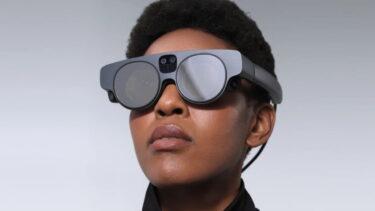
March 16, 2022:
Partially updated and new information added
Augmented reality comes in many forms and variations. What devices are out there, and what are their pros and cons? An overview.
This article attempts a general categorization. Its purpose is to provide an overview of the main classes of devices, while reflecting the evolution of the last five years: from AR-enabled mobile devices, to AR headsets such as Hololens and Magic Leap, to the first mixed reality headsets.
The fifth class of devices, AR glasses, describes the goal of much of the AR industry and has not yet materialized in this form. The sixth category revolves around tech contact lenses, which are even further away from market maturity than tech glasses. It should be seen as a glimpse into the future of the technology.
Content
Mobile AR
Other terms or subtypes: Smartphone AR, Tablet AR
Well-known examples: ARKit, ARCore
Advantages: widespread use, mature interfaces
Disadvantages: cumbersome to use, small display, no stereoscopic vision, limited interactivity
Mobile AR is augmented reality using mobile devices such as smartphones and tablets. They use a camera and other sensors, as well as computer vision, to display digital objects and information contextually in physical space. The digital and physical elements merge on the display of the smartphone or tablet.
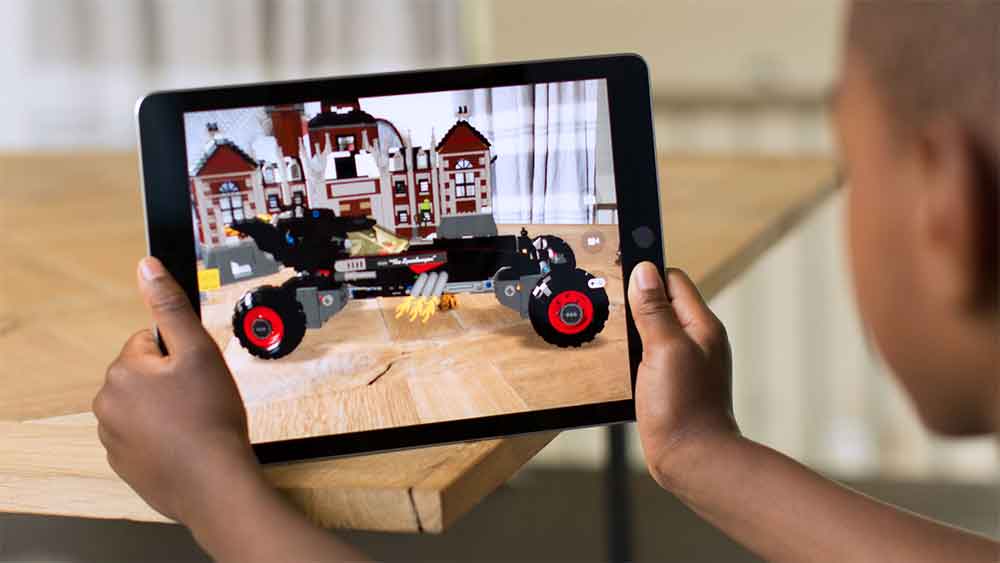
Mobile AR projects digital objects realistically into the physical environment. | Image: Apple
The first mature frameworks for Mobile AR were Vuforia and Wikitude. In 2017, Mobile AR reached the masses with the introduction of Apple's ARKit and its into iOS. Google followed Apple's lead in 2018 with ARCore, a solution for Android devices. Other influential mobile AR frameworks include Meta's Spark AR, Snap AR, and 8th Wall, which was acquired by Niantic.
With the ubiquity of smartphones, mobile AR is the most common and widely used form of augmented reality. The most popular applications include AR games like Pokémon Go, face filters, Google's AR search or niche apps for very specific application scenarios like picture frames.
Smartglasses
Other terms or subtypes: Video glasses, camera glasses, audio glasses
Well-known examples: Google Glass, North Focals, Ray-Ban Stories, Echo Frames, Snap Spectacles (1-3)
Advantages: comparatively slim form factor
Disadvantages: weak to no AR functionality, narrow field of view
This class includes devices that are based on the form factor of conventional eyeglasses and are designed to be as lightweight as possible, but offer only rudimentary augmented reality: They superimpose useful information in the field of view (Google Glass, North Focals) or beam virtual screens into the room (Nreal Air), without spatial tracking or consideration of the physical environment.
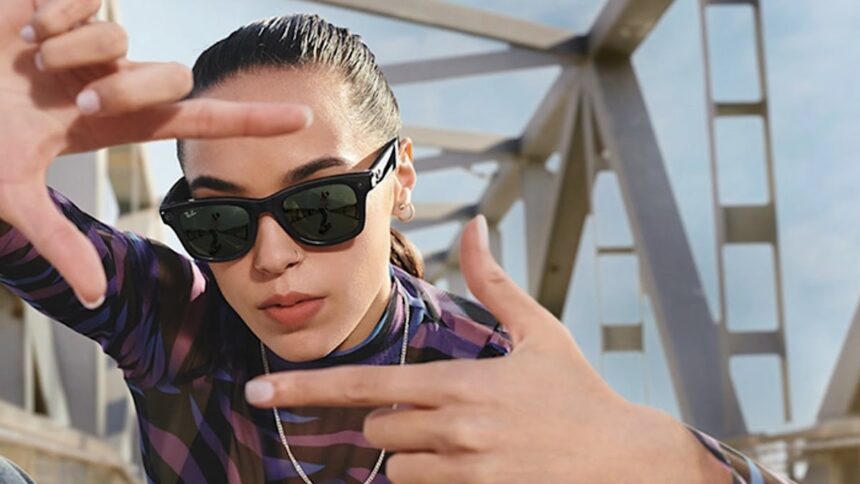
The Ray-Ban Stories with two integrated cameras is almost indistinguishable from a normal Ray-Ban. The slim form factor is partly due to the fact that it doesn't have a screen. | Image: Meta / Ray-Ban
Other devices in this class do not have a display, but offer alternative smart functions such as cameras and speakers (Ray-Ban Stories) or voice assistance (Echo Frames). In all cases, the very limited AR functionality is due to technical reasons: The miniaturization of AR technology is only rudimentary.
The rather narrow field of view and the associated limited use of the devices in terms of content have so far prevented wider distribution. In some cases, the data glasses are still visually recognizable as such and therefore not socially acceptable. Google Glass flopped because of this and the integrated camera, which sparked a controversy about privacy and data protection.
AR headsets
Other designations or subtypes: Seethrough AR headsets
Well-known examples: Microsoft Hololens (2), Magic Leap (2), Snap Spectacles (4)
Advantages: Advanced AR functionality
Disadvantages: comparatively bulky, narrow field of view, expensive
AR headsets have a different premise than smart glasses: Sacrifices in form factor are accepted to make room for important basic augmented reality features such as spatial tracking and 3D mapping of the environment.
These devices differ from conventional glasses in their bulky form factor, which is why this category is called AR headsets instead of AR glasses (see category 5).
The best-known AR headsets are Microsoft Hololens and Magic Leap. The first Hololens launched in 2016, followed by the Magic Leap 1 in 2018 and the Hololens 2 in 2019. The Magic Leap 2 launched in 2022.
The high price, experimental technology, and appearance of these devices make them unattractive to consumers. The primary customers are businesses, professionals, and AR enthusiasts who develop custom applications for the headsets and specific usage scenarios.
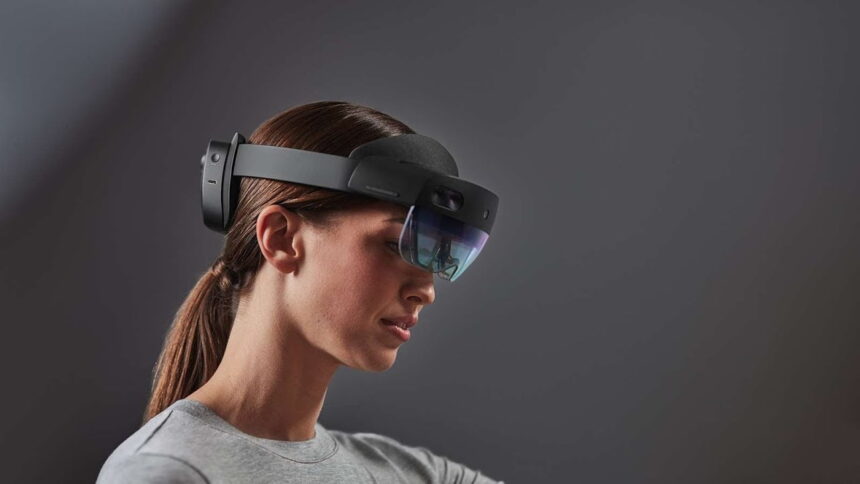
Hololens 2: Good AR technology, but not yet suitable for everyday use due to form factor and display shortcomings. | Image: Microsoft
Hololens 2 and Magic Leap 2 made advances in areas such as form factor, comfort, usability, and field of view. However, they did not achieve a technical breakthrough that would make the devices interesting to consumers.
The future of Hololens is uncertain: Microsoft has laid off many employees working in the XR field and the development of the IVAS military Hololens is facing many difficulties. If Microsoft were to exit the AR hardware business, Magic Leap would be the only major player left in the AR headset market.

AR devices like Snap's Spectacles are making progress in terms of form factor, but they are still too big for everyday outdoor use. Manufacturers also make technical compromises for the relatively compact form factor. For example, Spectacles have a very small field of view of about 30 degrees and only last 30 minutes per charge. | Image: Snap
Nreal Light and Snap's latest Spectacles are interesting hybrids. Both look more like traditional sunglasses and offer basic AR functionality. However, they do not come close to the technical capabilities of real AR headsets. The form factor is slimmer than a headset like Hololens, but still significantly clunkier than regular glasses.
Mixed reality headsets
Other terms or subtypes: Passthrough AR headsets
Examples: Meta Quest Pro, Lynx R-1, Varjo XR-3
Pros: currently the best AR functionality, wide field of view
Disadvantages: bulky, closed form factor (opaque displays)
AR headsets like Hololens and Magic Leap direct light from an image projector into a transparent glass called a waveguide, which then casts the image into the eye. The technology is still in its infancy, and is complex and expensive to manufacture.
Mixed reality headsets, on the other hand, are based on the same design principle as VR headsets, which makes them easier to manufacture and reduces costs because they are based on a largely established technology. They are expected to be the best hardware for advanced augmented reality in the coming years.
Mixed Reality headsets have cameras built in that film the environment and transmit it as a video image to the opaque screens. This creates the illusion of seeing the surrounding world, which can be augmented and overlaid with digital elements on the displays as desired.
This so-called passthrough technology has great advantages over classic AR headsets with transparent optics such as a much wider field of view, opaque display of digital objects and closer interaction between physical and digital reality.
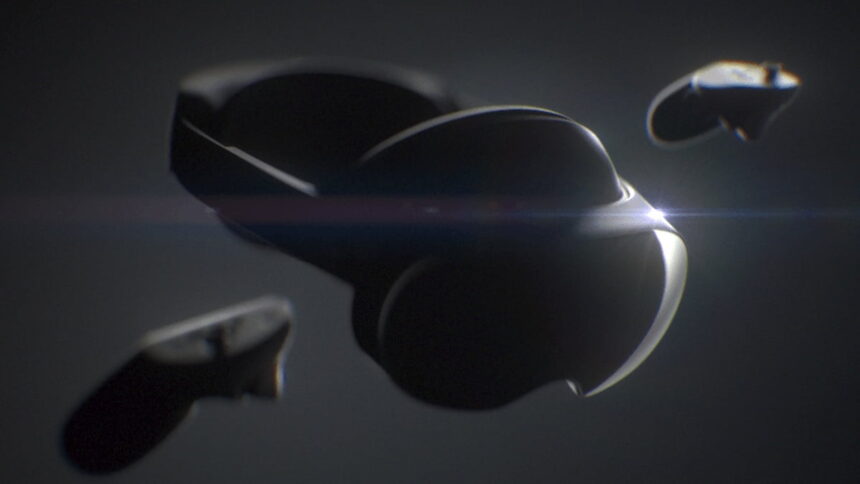
The Meta Quest Pro mixed reality headset has a similar form factor to the Hololens 2. Mixed reality headsets are unlikely to get much smaller in the near future. | Image: Meta
That's why so many companies are currently pinning their hopes on mixed reality headsets. Meta Quest Pro and Lynx R-1 are the first to market, and similar headsets from Apple, Google, and Samsung are expected to follow.
While the form factor of mixed reality headsets enables advanced AR, it is also the biggest drawback: like VR headsets, the devices are bulky and have limited suitability for everyday use, so their use is likely to be largely limited to indoor and designated areas.
AR glasses
Examples: -
Theoretical Advantages: Glasses form factor, excellent AR functionality, wide field of view
Theoretical Disadvantages: open questions regarding data protection and privacy, technical infrastructure is a major challenge
Stylish and comfortable glasses with AR capabilities that assist wearers in their daily lives, project lifelike holograms into the environment, and blend analog and digital reality: that's the dream the AR industry has been working toward for years.
The list of technical challenges is long: A proper pair of AR glasses would have to provide immense computing power for the complex tasks involved in AR processing and still have enough battery power for an entire day, much like our smartphones today.
In addition to the processors, two or more cameras must fit into the frame of the glasses to help them navigate their environment and recognize places, objects, and people. The glasses must not be too heavy or too warm. Otherwise, they'll get uncomfortable.
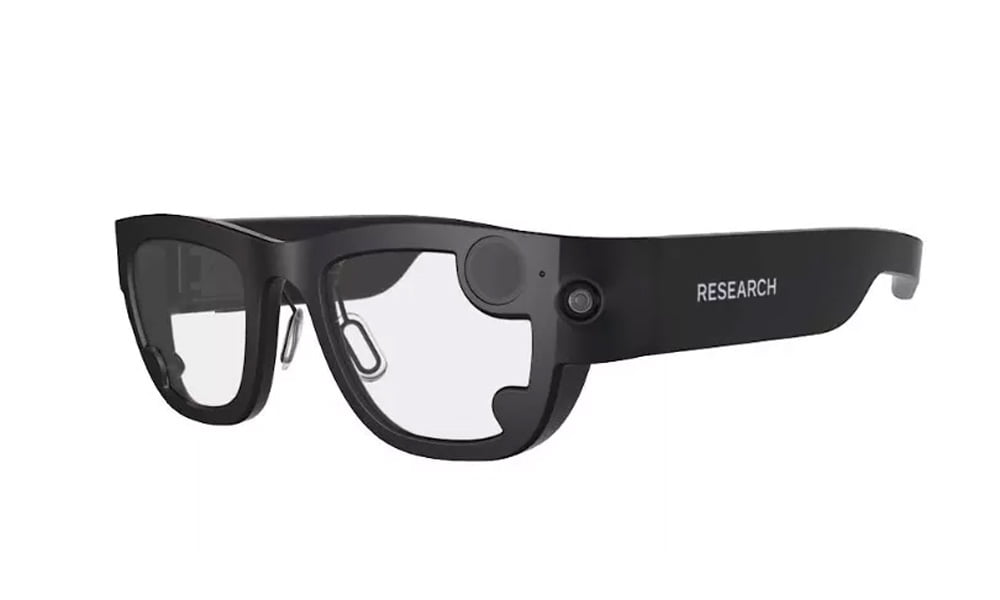
With Project Aria, Meta is exploring the foundations for the future of AR glasses. The current prototype is fully functional: The first testers are using them to collect everyday data via cameras and depth sensors. However, the glasses do not have a screen or graphics unit. The form factor is close to what Meta and other tech companies are realistically aiming for. | Image: Meta
One possible solution to some of the technical challenges is 5G streaming: Content comes from the cloud, the glasses "only" have to project it into the environment and enable interaction. In this way, some of the computing load could be offloaded and the glasses could be made slimmer.
But even if these problems are solved, there is still the question of how the public will react to AR glasses that continuously film and analyze their surroundings. This debate has yet to take place. The experience with Google Glass suggests that it is likely to be complicated. Meta's Ray-Ban camera glasses are already facing privacy concerns.
Meta's first true AR glasses are slated for 2027, according to a leaked roadmap, while a simpler pair of Ray-Ban smartglasses with a HUD is expected in 2025. Apple has postponed its AR glasses indefinitely, according to one report.
AR contact lenses
Even more futuristic than slim AR glasses are AR contact lenses. Start-ups such as Mojo Vision and Inwith are presenting the first technically impressive prototypes. However, their functionality is still rudimentary, and AR-enabled tech lenses are much further from market readiness than AR glasses.
The Mojo Lens prototype can display content in a 15-degree field of view directly on the retina. Using eye tracking, the lens detects where the eye is looking and adjusts the image accordingly. Currently, the display can only show green, and the lens does not offer spatial or object recognition.
Medical applications for certain eye diseases, such as contrast enhancement, are more likely for the time being. An external feed such as a pocket computer or cloud streaming is definitely required.
In early 2023, Mojo Vision announced that it had not found investors for the further development of AR contact lenses. The startup shut down the project, laid off most of its employees, and shifted its focus to the development of microLED displays.
Note: Links to online stores in articles can be so-called affiliate links. If you buy through this link, MIXED receives a commission from the provider. For you the price does not change.